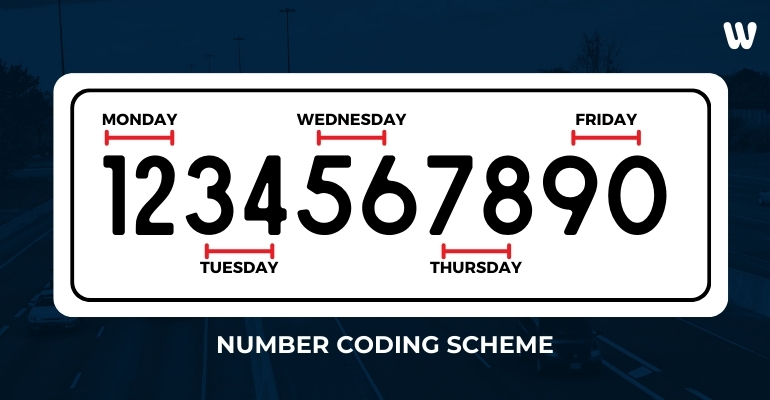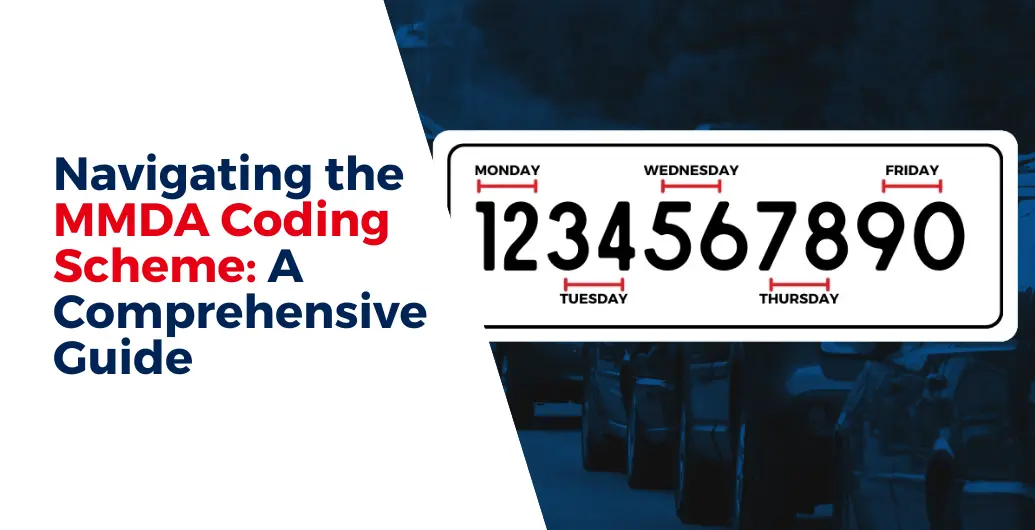The Metropolitan Manila Development Authority (MMDA) is responsible for implementing the Metro Manila Coding annually. As such, they are responsible for the coding scheme this 2024. First introduced in 1995 in response to the critical traffic conditions within the capital, the MMDA coding scheme holds the primary purpose of addressing the perennial issue of traffic congestion.
The growing development of Metro Manila in the Philippines and the spread of urbanization has led to an increase in vehicle use. With that, the MMDA 2024 coding guidelines serve as a general measurement in managing traffic on specific days. However, it is important to take note that coding schemes are regularly undergoing adjustments to meet the recent changes and needs in mitigating growing traffic matters.
Table of contents
- The MMDA Coding Scheme
- Implementation and Schedule
- Weekday Restrictions
- Hours of Enforcement
- Exemption Policies
- Affected Vehicles and Areas
- Types of Vehicles Covered
- Major Roads and Thoroughfares
- City-Specific Information
- Exemptions and Special Cases
- Public Service and Emergency Vehicles
- Perishable Goods and Heavy-Duty Trucks
- Special Permits and Window Hours
- Penalties and Enforcement
- Changes to the MMDA coding scheme
- Final Thoughts
The MMDA Coding Scheme
The MMDA coding scheme for 2024 has taken on recent updates in answering the latest traffic guidelines and potential issues within Metro Manila. The coding focuses on implementing the number coding on the vehicle’s registration. The numbers indicate the specific days that restrict the registered vehicle from entering major roads.
Implementation and Schedule
The coding scheme is active on a daily basis, with holidays and weekends being the only days of exception. The day of vehicles are restricted based on their license plate number and registration. This approach focuses on mitigating heavy traffic evenly.
Weekday Restrictions
As mentioned earlier, restrictions apply on certain days according to the last digits of one’s license plates. Here is the number coding scheme schedule for Monday to Friday:

- Mondays for Plate Numbers ending in 1 and 2
- Tuesdays for Plate Numbers ending in 3 and 4
- Wednesday for Plate Numbers ending in 5 and 6
- Thursdays for Plate Numbers ending in 7 and 8
- Fridays for Plate Numbers ending in 9 and 0
Hours of Enforcement
Enforcement of the 2024 coding guidelines is active within peak traffic hours from 7:00 AM to 8:00 PM. These hours are also where most people will go on the road.
Exemption Policies
Certain types of vehicles fall under the exemption from falling under the number coding scheme. These include:
- Motorcycles
- Ambulances
- Fire trucks
- Police patrol
- Military vehicles on official functions
- Diplomatic vehicles
- Government vehicles in official use
- Official media vehicles
- Makati-accredited tow trucks
- Any vehicle used by medical practitioners in an emergency
- Vehicles with senior citizen Blu Card holders
Also Read: MMDA implements “Tickets or Treats” program in Metro Manila
Affected Vehicles and Areas
The coding scheme is designed for all private vehicles from cars and motorcycles. Additionally, the scheme is implemented across all major roads in Metro Manila.
Types of Vehicles Covered
The coding scheme of 2024 still revolves around both private and public utility vehicles. However, the Republic Act No. 11697 Electric Vehicle Industry Development Act (EVIDA) exempts electric vehicles (EVs) and hybrid automobiles from the coding scheme. To qualify, the certificate of registration of the vehicle should state that it’s a hybrid.
Major Roads and Thoroughfares
Authorities commonly concentrate the enforcement of the coding scheme on major roads and thoroughfares across Metro Manila. Hence, this leads to a substantial impact on overall traffic flow within the metro.
City-Specific Information
While the coding scheme is specifically designed for traffic improvements within Metro Manila, some cities within the capital have slight variations. These cities adjust the coding system conditions to meet their local traffic pattern.
Alabang
Muntinlupa City does not have a number coding scheme except for the following roads that use the MMDA’s coding scheme.
- Ayala-Alabang National Road
- Alabang-Zapote Road corner Buencamino and North Gate
A fine of P500 on the first offense, P750 on the second offense, and P1,000 on the third and succeeding offenses are given to those who violate the coding scheme. Do note that these penalties and coding schemes were prior to the pandemic. As such, some rules may have changed.
Makati City
Known as Metro Manila’s Central Business District, Makati City has no window hours, which means that the number coding rule applies from 7 a.m. to 7 p.m. Note that there’s a standard fine of P300 on violators. However, Makati City does exempt vehicles carrying senior citizen Blu Card holders as drivers or passengers and those under official functions and medical emergencies as stated in the Makati code.
Quezon City
Quezon City now follows the MMDA’s coding scheme of 7 AM to 10 AM and 5 PM to 8 PM, with window hours from 10:01 AM to 4:59 PM.
Pasig City
As Pasig City is part of Metro Manila, it follows the MMDA’s coding scheme of 7 AM to 10 AM and 5 PM to 8 PM, with window hours from 10:01 AM to 4:59 PM.
Pasay City
If you’re living in Pasay and your vehicle is coding, note that this city has a number coding scheme from 7 AM to 10 AM and from 5 PM to 8 PM coding period with a window period of 10 AM to 4 PM. However, this coding doesn’t apply to thoroughfares such as Domestic Road, Ninoy Aquino Avenue, MIA Road, Sales Road, parts of Airport Road, and parts of Buendia (Gil Puyat).
Paranaque City
In Paranaque City, they follow the standardized coding scheme set up by the MMDA. This means that there is coding between 7 AM to 10 AM and from 5 PM to 8 PM coding period with a window period of 10 AM to 4 PM. Thus, this follows the implementation of the coding scheme that was brought back in August of 2022.
Mandaluyong City
As of August 2022, Mandaluyong City now follows the MMDA’s coding scheme. This means that there is coding from 7 AM to 10 AM and from 5 PM to 8 PM with a window period of 10 AM to 4 PM.
Manila City
Certain locations implement the number coding scheme schedule in Manila without window hours for 2024. However, some roads are set to follow the 7 AM to 10 AM and from 5 PM to 8 PM coding period with a window period of 10 AM to 4 PM.
Valenzuela City
The number coding scheme is implemented in Valenzuela City, which starts from 7 AM to 10 AM and from 5 PM to 8 PM coding period with a window period of 10:01 AM to 4:59 PM as of August of 2022 with the MMDA’s reimplementation of its coding scheme.
This program takes effect on these roads:
- MacArthur Highway
- Maysan – Paso De Blas – Bagbaguin Road
- Karuhatan – Gen. T. De Leon Road
- Gov. I. Santiago Road (Malinta to Tatawid)
- Mindanao Avenue (Barangay Ugong)
- East and West NLEX Service Road
- T. Santiago Road
- Sapang Bakaw (Lawang Bato) – Punturin – Bignay Road
Taguig City
The city of Taguig is partially exempted from the coding scheme. That said, there are still some selected areas that implement the coding scheme. Specifically national roads within its boundaries, including East Service Road, and Manuel L. Quezon Avenue.
San Juan City
The City of San Juan is currently practicing the number coding scheme scheduled from 7 a.m. to 7 p.m. Along with its respective timeframe, restricted vehicles are allowed to roam during window hours which commence from 10 a.m. to 3 p.m. We have yet to receive information from the city if they have adopted the implementation of the 7 AM to 10 AM and from 5 PM to 8 PM coding period with a window period of 10 AM to 4 PM.
Caloocan City
In Caloocan City, motorists observe its number coding scheme that runs from the usual 7 AM to 10 AM and from 5 PM to 8 PM coding period. While other roads within the vicinity of Caloocan are granted the 10 AM to 4 PM window hour system, Samson Road has been left exempted. This means restricted vehicles are not allowed to traverse the said area throughout the entire number coding scheme period. Do note that these penalties and coding schemes were prior to the pandemic. As such, some rules may have changed.
Exemptions and Special Cases
Some exemptions towards the coding schemes may be applicable to specific cases, such as medical emergencies. Thus, it ensures public safety and welfare.
Public Service and Emergency Vehicles
Additional exemptions are public services and emergency response vehicles. These include police, ambulances, and fire trucks. Thus, to ensure they can carry their services and respond quickly to emergencies and critical situations.
Perishable Goods and Heavy-Duty Trucks
Any vehicle that transports perishable goods, such as heavy-duty truck deliveries, has special exemptions and considerations. This ensures the efficient delivery and transportation of goods within the metro.
Special Permits and Window Hours
Certain vehicles may garnet special permits for limited exemptions and considerations. This is for specific purposes, and the coding scheme is temporarily lifted to accommodate to unique purposes and circumstances.
Penalties and Enforcement
Failure to follow the coding schemes can result in penalties and measures. Strict enforcement is a means of encouraging compliance and mitigating traffic offenses.
Changes to the MMDA coding scheme
The MMDA number coding scheme schedule and guidelines of 2024 have implemented several changes in comparison to the previous years. For instance, there are alterations to the morning and evening coding hours, including rush hours and heavy traffic scenarios.
A notable change also now exempts public utility vehicles from the revised number coding schemes. The coding focuses its priorities on commuter mobility and convenience during morning and evening coding hours.
The revised schemes aim to meet the dynamic changes in traffic and optimize the flow on Metro Manila’s roads.
Final Thoughts
The substantial changes to the number coding scheme schedule for 2024 are to address the latest conflicts and changes within traffic and road policies. The coding’s evaluation is a proactive approach with the use of new policies and exemptions in properly managing traffic restrictions.
To sum things up, motorists and commuters should stay informed and updated about the revised changes within the 2024 coding guidelines and the latest news from the MMDA.
Sources: (1), (2), (3), (4), (5)
Keep Reading: How to be a Grab Operator in the Philippines



Leave a Reply